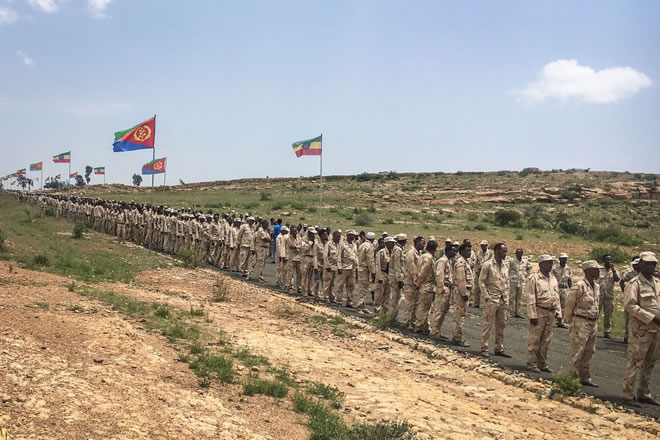Alex de Waal
Friday March 5, 2021

Eritrean soldiers wait in line to cross the border to attend a reopening ceremony with Ethiopia in Serha, Eritrea, on Sept. 11, 2018. STRINGER/AFP/GETTY IMAGES
After months of bloodshed in Tigray, a region of Ethiopia claiming the right of self-determination, the United States is ramping up pressure to end hostilities, protect civilians, facilitate an independent investigation of atrocities, and permit humanitarian access to starving populations. In a call to Ethiopian Prime Minister Abiy Ahmed Ali on March 2, U.S. Secretary of State Antony Blinken repeated his call for the immediate withdrawal of all Eritrean troops from Tigray that are operating there as part of the Ethiopian effort to quash the rebellion. This last point is emerging as a central demand, since most of the crimes in Tigray documented by journalists and human rights groups were carried out by Eritrean forces.
These atrocities are ongoing. On March 1, leading Tigrayan scholar Mulugeta Gebrehiwot, in a rare phone call from the mountains, described how Eritrean troops had razed villages, cut down mango orchards, destroyed irrigation systems, and slaughtered dozens of people from young children to grandparents in the town of Samre and the villages of Gijet, Adeba, and Tseada Sare in recent days. “Famine is coming,” he said. We should heed Mulugeta’s warning: Action now is essential to stop further crimes and a vast humanitarian catastrophe.
Eritrean President Isaias Afwerki rules a tiny nation of 3.5 million people, with a GDP of $2 billion as of 2018. But the country’s military is vast; its army has an astonishing 200,000 people, most of them enrolled in compulsory and indefinite national service on reaching eleventh grade. Eritrea doesn’t publish a budget, but an estimated 20 percent of the country’s GDP is spent on the military as well as an undisclosed sum on Isaias’s much-feared national security and intelligence services.
Several recent reports make clear just what Eritrean security and military forces are capable of. Over the last week, three different reports attributed atrocity crimes in the war in Tigray to Eritrean forces. Amnesty International documented a November 2020 massacre in a cathedral in Axum, where hundreds of civilians were slaughtered. CNN compiled and cross-checked reports of a mass killing at a monastery called Maryam Dengelat, where more than 100 people died. And VICE World News matched satellite photos of destroyed villages with eyewitness accounts to detail other atrocities.
And the fighting, burning, and forced starvations continue. Last week, satellite imagery showed at least 508 buildings burning in and around the town of Gijet in southern Tigray. This is close to the area where Tigray’s defense forces destroyed an Ethiopian armored division two weeks earlier, and in phone calls to me from the area, Tigrayans reported five Eritrean divisions—about 10,000 soldiers with tanks backed by both Ethiopian and Eritrean combat aircraft—converging on the area conducting what they called a “scorched earth” operation.
In July 2018, when Abiy flew to the Eritrean capital, Asmara, to sign a long-overdue peace agreement between the two countries, citizens of both countries hoped the occasion would push Isaias to at last begin to demobilize his army; redirect his national budget to spending on health, education, and development; and liberalize his politics. None of that happened. It’s now clear that Isaias saw the peace deal as a security pact with Ethiopia to eliminate the Tigray People’s Liberation Front’s (TPLF) leadership, which is leading the uprising in Ethiopia—and inflict such damage on the Tigrayan people that they could never again challenge either country.
Isaias’s animosity to the TPLF dates back to a dispute between him and TPLF leaders, then-Ethiopia’s leaders, which led to a border war in 1998 that he lost. The Ethiopian army under the TPLF didn’t march all the way to Asmara and impose regime change, but it might as well have.
In the wake of defeat, Eritreans themselves clamored for change: First, a group of democracy activists petitioned for reform, and then 15 of the most senior Eritrean politicians—known as the G-15—followed suit. In the brief “Asmara Spring” of 2001, an independent press flourished, and Eritreans demanded that all freedoms promised after the country’s independence eight years earlier—and contained in the new constitution finalized in 1997 but never adopted—should be realized.
The G-15 included Isaias’s oldest comrades-in-arms and all heroes of the war for independence, including former foreign ministers and defense ministers and some of the founders of the Eritrean People’s Liberation Front. Likely feeling encircled, Isaias’s response to demands for reform was to clamp down. On Sept. 18 and 19, 2001, he arrested 11 of the G-15 and consigned them to literal oblivion; they have not been seen or heard from since. Neither have Eritreans seen or heard of their cherished constitution and freedoms. Instead, all independent media were closed, journalists were imprisoned, and religious freedoms were circumscribed. Compulsory national service for all school leavers was introduced.
To divert attention from his own military adventurism and growing authoritarianism, Isaias tried to blame his nation’s ills on Ethiopia—and especially the TPLF. And he supported any opposition group ready to wage war against Ethiopia, including Somali jihadists. That last venture prompted a fierce U.S.-led backlash that included placing the country under sanctions in 2007 before lifting them in 2018.
Alex de Waal is the executive director of the World Peace Foundation and a research professor at the Fletcher School of Law and Diplomacy.